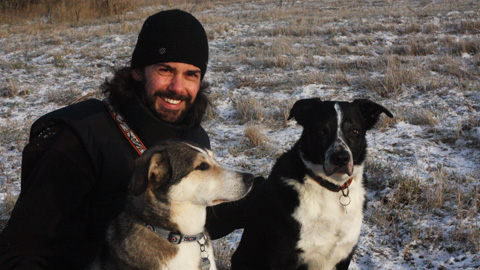Man’s Best Friend Originated in Europe
An international research team led by Postdoctoral Research Fellow Olaf Thalmann from the University of Turku has discovered the origin of dog domestication.

Domestication in action: Postdoc Olaf Thalmann and his two dogs Kira and Higgins.
The research group has found out that all modern dogs are most closely related to ancient wolves from Europe. The process of dog domestication began about 18,800-32,100 years ago.
 The quest to find out from where and when modern dogs were domesticated has sparked much controversy over the years and no consensus has yet been reached. A team of geneticists and paleontologists from Finland, the USA, Germany, Belgium, Russia, Spain and Argentina may now have put the debate to an end by providing new insights into the origin and the timing of dog domestication.
The quest to find out from where and when modern dogs were domesticated has sparked much controversy over the years and no consensus has yet been reached. A team of geneticists and paleontologists from Finland, the USA, Germany, Belgium, Russia, Spain and Argentina may now have put the debate to an end by providing new insights into the origin and the timing of dog domestication.
– Whereas dogs are now omnipresent in many human cultures, the formation of this close relationship between the two species was a gradual process, Thalmann tells.
Fossils Reveal the Story
The team of scientists used novel molecular techniques to capture and analyze DNA from fossil remains such as bones and tooth roots. The research included material from the earliest putative dogs from Europe, Asia and America dating back as far as 36,000 years.
By investigating the mitochondrial genomes of 18 ancient wolves/dogs and comparing those to a large collection of genomes from modern wolves and dogs, the researchers were able to show that all modern dogs are most closely related to ancient wolves/dogs from Europe.
It also became apparent that no extant wolf population is more closely related to modern dogs than the extinct specimens suggesting that the population of European wolves that ultimately gave rise to today’s dogs has gone extinct.
Hunting Companions
Given the vast amount of genetic data analyzed from fossil and modern specimens, the researchers were able to determine the time at which the process of dog domestication might have begun.
 - We narrowed down the time frame and evaluated that the domestication process began about 18,800-32,100 years ago, Thalmann says.
- We narrowed down the time frame and evaluated that the domestication process began about 18,800-32,100 years ago, Thalmann says.
Conceivably, the first step was a simple, mutually beneficial, co-existence of humans and proto-dogs, when the latter moved into closer proximity of the human settlements.
– The time frame implies that the domestication of dogs was initiated before the last glacial maximum by European hunter-gatherers. They have learnt to appreciate the benefits of taming the large and dangerous carnivores and used them for hunting, transport or protection, Thalmann ponders.
The Mystery of the Earliest Dogs
Surprisingly, the mitochondrial genomes of the earliest putative dogs, which were older than 30,000 years, did not turn out to be directly ancestral to modern dogs. This finding is suggestive of an earlier aborted domestication episode or alternatively, the existence of a previously unrecognized population of Pleistocene wolves.
However, younger ancient specimens arranged closely with modern dogs. Amongst these is the 14,700 year old specimen from Bonn-Oberkassel in Germany which was designated as a dog already in 1979 based on morphological evidence and can now also be confirmed by genetic data as well.
– Our study is certainly a significant contribution to solving the question of when and where dogs originated. However, investigating new fossils and the nuclear genomes of ancient wolves and dogs might eventually offer new surprises in the history of ‘humankind’s best friend’, Thalmann concludes.
More information:
>> The article has been published in the journal Science: Thalmann et al. "Complete mitochondrial genomes of ancient canids suggest a European origin of domestic dogs".
Text: Henna Borisoff
Photographs of the article: Doreen Schwochow-Thalmann and Sonja Pauen
Photograph on the front page “carousel” of the university: CGehlen